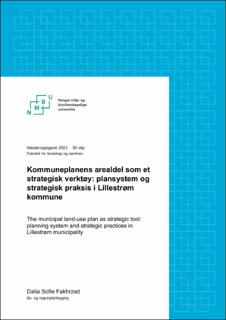| dc.contributor.advisor | Marius Grænning | |
| dc.contributor.author | Fakhrzad, Dalia Sofie | |
| dc.date.accessioned | 2022-04-08T16:27:12Z | |
| dc.date.issued | 2021 | |
| dc.identifier | no.nmbu:wiseflow:6444327:47498261 | |
| dc.identifier.uri | https://hdl.handle.net/11250/2990809 | |
| dc.description.abstract | I 2008 fikk vi en ny plan- og bygningslov som satte bærekraftig utvikling på agendaen. Likevel ser vi at mye av dagens utvikling er basert på vilkårlig planlegging og at kommunens målsetninger ikke alltid holder mål i fysisk planlegging. Dette resulterer i at vi ser at stort avvik mellom kommunens målsetninger og den fysiske virkeligheten. I ytterste konsekvens saboterer dette for formålet med planleggingen som er at den bygger på verdiene om bærekraftig utvikling. Siden bærekraft utvikling favner bredt, innebærer det at planlegging blir et viktigere verktøy innfor flere politikkområder, som også løser store samordningsoppgaver. Dette innebærer at kommunen må innta en mer proaktiv rolle i utviklingen av steder og byer. Like fullt kan vi se at mye planlegging er ren saksbehandling av private planinitiativer. Strategisk planlegging som tilnærming er avgjørende for å kunne møte mange av dagens største utfordringer. For å sikre politisk styringskontroll må kommuneplanens arealdel ha en legitimitet som muliggjør at kommunen, med lovhjemmel, kan utvikle samfunnet i en bærekraftig retning.
Litteratur om strategisk planlegging har blomstret de siste tiårene, i blant snakker man om et strategisk skifte også i norsk planlegging. Likevel jobber kommunen, som arealmyndighet, i hovedsak med de tradisjonelle plantypene som er juridisk bindende og som regulerer arealene. I denne oppgaven ser vi på hvilke erfaringer man han gjort i Lillestrøm kommune med strategier og samordningsoppgaver.
Først ser vi på systemutviklingen nasjonalt, hva man gjorde med plan- og bygningsloven for å kunne planlegge på en strategisk måte. Vi identifiserer hvilke strategiske funksjoner som har blitt styrket i plansystemet og hvilke virkemidler som ble innført for å bygge opp under disse. Deretter studerer vi noen konkrete planprosesser som har funnet sted i kommunen. Ved å undersøke hva slags overordnet grep kommunen har tatt for sin utvikling, i uformelle og formelle planer, hvordan kommunen tolker sitt strategiske handlingsrom, og hvordan strategier implementeres i mere detaljere avklaringer og planer, får vi et bilde av hvordan plansystem og strategiske virkemidler utnyttes i dagens praksis.
Det viktigste overordnede verktøyet kommunen har til å styre sin romlige utvikling i et langsiktig perspektiv, er kommuneplanen og ikke minst arealdelen, som har virkemidlene til å disponere arealer og styre utviklingsprosessene over tid. Undersøkelsen av senere utvikling av plansystemet og praksis i Lillestrøm kommune, gir oss en pekepinn på hvordan kommuneplanens arealdel har fått et viktig strategisk innhold og hvordan man best kan utnytte dette verktøyet til strategiarbeid. | |
| dc.description.abstract | The Planning and Building Act of 2008 brought sustainable development to light within contemporary planning. Planning appears to be arbitrary, resulting in less-than-ideal results of the physical planning. Furthermore – there seems to be a substantial disconnect between municipalities self-reported predetermined targets and the empirical observations. Consequently, the underlying target of sustainable development is undermined. Sustainable development, as a broader societal value, underscores the importance of planning within several areas of policy. This calls upon municipalities to undertake a more proactive approach to executing city- and regional development. Contemporary planning also seems, at times, reduced to case processing of private initiatives. Incorporating strategic planning as an approach to development appears crucial in facing contemporary challenges. To ensure political control, the area-section of the municipal plan must be legitimate, permitting the municipality to develop society in a sustainable manner with legal authority.
The literature of strategic planning has been significantly expanded the latter decades – and talk of a “strategic shift” is evident also in Norwegian planning. As the land-use authority, the municipalities are mainly concerned of the traditional approaches to planning – which are legally bound and regulate the areas. This thesis examines the experiences of strategizing in Lillestrøm municipality.
First – we examine the national revision of the planning-system. We identify the strengthened strategic functions, and reveal actions that were implemented to aid these. Subsequently we study some concrete planning-processes that have taken place in Lillestrøm. By examining what kind of overall action the municipality has taken for its development, in informal and formal plans, how the municipality interprets its strategic scope for action, and how strategies are implemented in more detailed clarifications and plans, we get an impression of how planning systems and strategic instruments are currently being utilized.
The critical tool to manage a municipality’s spatial development in a long-term perspective is the municipal plan, particularly the area part, which has the tools to dispose of areas and manage the development processes over time. The study of later development of the planning system and practice in Lillestrøm municipality, gives us a clue as to how the municipal land-use plan has been provided necessary strategic content - and how this should be utilized as a tool for strategy. | |
| dc.language | nob | |
| dc.publisher | Norwegian University of Life Sciences | |
| dc.title | Kommuneplanens arealdel som et strategisk verktøy: plansystem og strategisk praksis i Lillestrøm kommune | |
| dc.type | Master thesis | |
